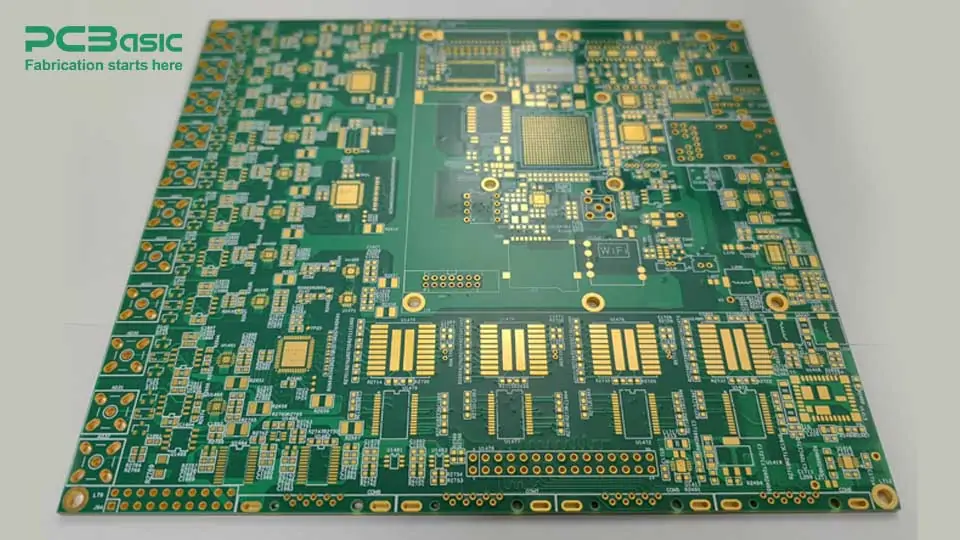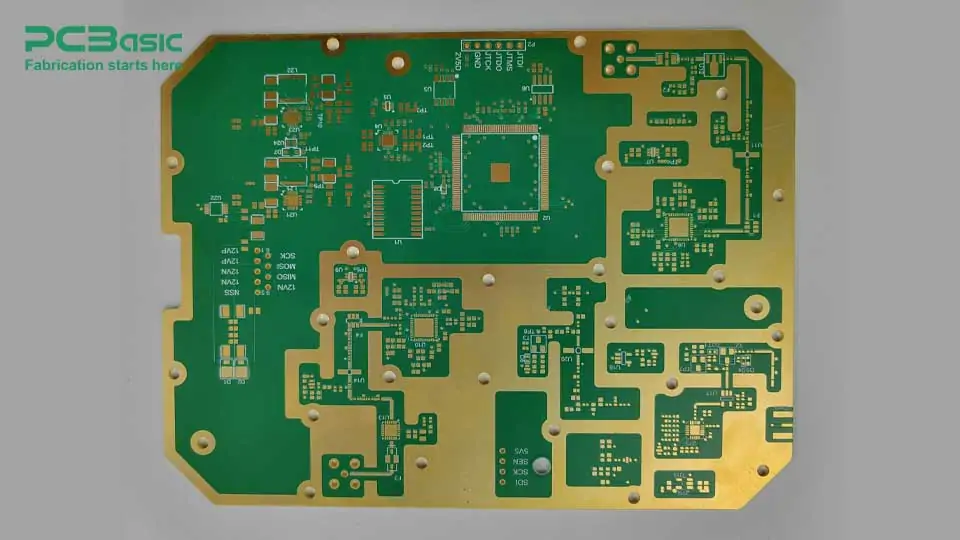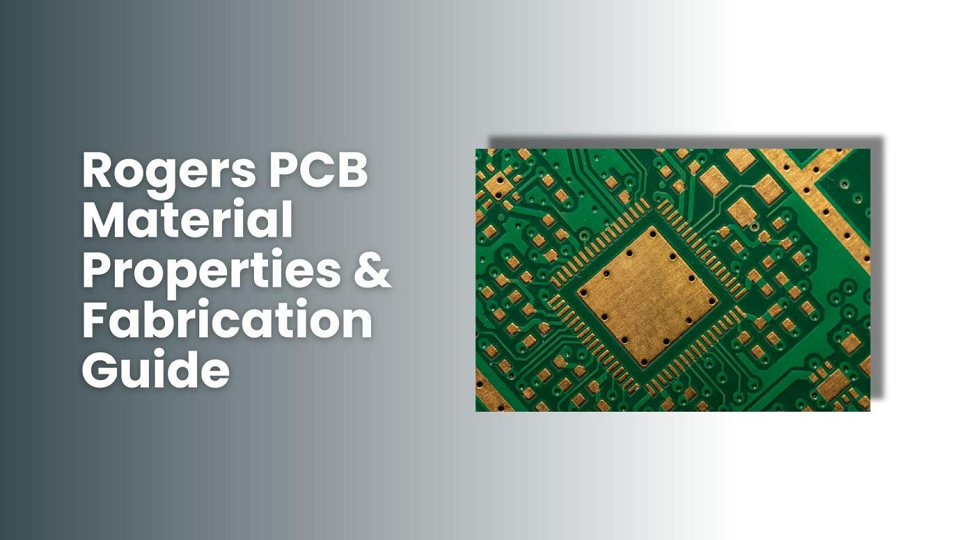Global high-mix volume high-speed Shenzhen PCBA manufacturer

Ru
9:00 -18:00, Mon. - Fri. (GMT+8)
9:00 -12:00, Sat. (GMT+8)
(Except Chinese public holidays)





Global high-mix volume high-speed Shenzhen PCBA manufacturer

Ru
9:00 -18:00, Mon. - Fri. (GMT+8)
9:00 -12:00, Sat. (GMT+8)
(Except Chinese public holidays)





HomePage > Blog > Knowledge Base > What is Rogers PCB? A Complete Introduction and Fabrication Guide
Rogers PCB is used to describe PCBs manufactured from Rogers PCB material, a high-performance laminate for use where stable electrical properties are needed. In contrast to the conventional FR-4 based on glass fabric and epoxy resin, Rogers materials use ceramic-filled PTFE or hydrocarbon resin systems. These materials possess outstanding dielectric properties, which are optimally suitable for microwave and high-frequency applications.
A number of industries prefer Rogers PCB manufacturing over normal FR-4 based on its reduced dielectric loss, enhanced thermal conductivity, and improved impedance control. These characteristics result in enhanced signal integrity, and Rogers laminates become the most popular choice for RF and high-speed digital circuits.

Rogers PCB material is well-known for:
● Minimum signal attenuation through low dielectric loss
● Stable frequency performance over a wide range of temperatures
● Effective removal of heat through good thermal conductivity
● Low absorption of moisture to operate in aggressive environments
● Dielectric constant (Dk) stability for accurate impedance control
Traditional FR-4 materials, as cost-effective as they are, are marred with disadvantages in high-frequency designs with high dielectric loss and low thermal stability. Rogers PCB, on the other hand, offers consistent performance across a broad frequency range and is, therefore, the first choice in RF, microwave, and aerospace applications.
Rogers Corporation has several material formulations for several applications:
● Rogers 4000 Series (RO4003C, RO4350B) – For RF/microwave circuits, antennas, and power amplifiers
● Rogers 3000 Series (RO3003, RO3035) – For satellite and automotive radar applications
● Rogers 6000 Series (RO6002, RO6010) – For aerospace and military applications
● RT/droid Series – For space-grade, high-power applications
All Rogers material PCB types differ in dielectric constant, loss tangent, and thermal performance. RO4003C, for instance, offers cost vs. performance, whereas RO3003 is the one that is optimized for the highest frequency stability needs. The appropriate formulation is selected depending on the particular electrical and mechanical needs of the application.

Because of the low loss tangent of Rogers PCB material, signals can propagate without a significant amount of attenuation, and thus are a good choice for high-speed and RF circuits. In particular, due to its high thermal conductivity, it is capable of providing superior heat dissipation which further decreases the chance of circuit failure.
For cost-constrained projects, a FR-4 Rogers PCB is made by laminating Rogers laminates and conventional FR-4 substrates. This hybrid method achieves performance in high-frequency parts and overall low cost. In critical RF layers, Rogers laminates are used for their high performance, and for less sensitive signal layers FR-4 is used.
Rogers PCB production is typically utilized in:
● Radar equipment
● Power amplifier
● RF antennas
● Hardware for satellite communications
Applications based on high-frequency performance, reliability, and temperature stability typically employ PCB Rogers:
● Avionics and defense applications
● 5G base station and infrastructure
● Automotive sensor and radar applications
● Dielectric Constant Stability: Rogers PCB is temperature- and frequency-stable in dielectric constant, whereas FR-4 is prone to variations that may affect performance.
● Loss Tangent: Lower in Rogers PCB, reducing signal loss at high frequency.
● Thermal Conductivity: Rogers laminates have greater thermal conductivity and hence are more appropriate for high-power applications.
● Moisture Absorption: Rogers materials have lower moisture absorption than FR-4, making them stable in performance upon exposure to moisture.
● High-frequency applications where signal integrity is critical
● Aerospace and military electronics where reliable performance in harsh environments is required
● 5G and telecommunication where low signal loss is critical
● Mixed FR-4 Rogers PCB configurations where performance and cost must be traded off
By choosing the right material, engineers can offer reliability, efficiency, and longevity to their PCB designs.
Rogers PCB materials are a mixture of ceramic-filled PTFE, hydrocarbon resin systems, or other high-frequency laminates. Unlike FR-4, which is epoxy-based resins and glass fabric, Rogers laminates have a more stable dielectric constant and lower loss tangent.
Common compositions are:
● PTFE (Polytetrafluoroethylene) with Ceramic Fillers – Used in applications where low signal loss and increased stability at high frequencies are required.
● Hydrocarbon-Ceramic Compositions – Used in cost-effective high-frequency circuit boards.
● Laminates with Copper Foil – Supplied with different copper thicknesses to meet specific electrical requirements.
The design of Rogers PCB material is a major cause of its electrical and thermal efficiency. The main benefits are:
● Lower Dielectric Loss – Reduces signal loss, making it well-suited for microwave and RF applications.
● Consistent Dielectric Constant (Dk) – Offers consistent impedance control, thereby reducing signal distortion.
● Improved Thermal Conductivity – Efficient heat spreading, which prevents overheating in power circuits.
● Less Moisture Absorption – Offers reliability in wet environments, making it especially well suited for aerospace and telecommunication applications.

Rogers PCB fabrication entails special procedures to accommodate material characteristics that are incompatible with standard FR-4. The most critical steps are:
● Material Selection – Choosing the correct Rogers laminate for frequency, thermal requirement, and mechanical stability.
● Lamination – Unlike FR-4, Rogers materials need controlled heat and pressure to avoid the warping of material.
● Drilling and Plating – Requires special care to avoid burring and ensure hole integrity, especially for high-density designs.
● Etching and Imaging – Copper layer is etched to get circuit traces with high tolerances.
● Surface Finishing – Standard finishes are ENIG (Electroless Nickel Immersion Gold) and OSP (Organic Solderability Preservative) for better solderability.
Manufacturing a Rogers PCB brings issues not encountered in conventional FR-4 manufacturing:
● Material Handling – PTFE-based laminates can be more flexible and must be handled gently to avoid warping.
● Adhesion Problems – Certain formulations call for specialized adhesives or plasma treatment in order to impart strong bonding.
● Thermal Expansion – The mismatch of copper and dielectric material must be controlled to prevent delamination.
● Higher Production Cost – In comparison with FR-4, Rogers PCBs bring higher-end manufacturing processes, which increase the cost of production.
Irrespective of these problems, the performance advantage of Rogers PCBs makes them the best fit for high-frequency, high-power, and RF applications.
Rogers PCB materials enjoy universal application in products requiring high-frequency performance, thermal stability, and low signal loss. Some of the most ideal applications include:
● RF and Microwave Circuits – Used in radar technology, satellite communications, and wireless networks where signal integrity is paramount.
● Aerospace and Defense – Durable against harsh temperatures and aggressive environmental conditions.
● Automotive Electronics – Ideal for advanced driver-assistance systems (ADAS) and vehicle-to-everything (V2X) communications.
● Medical Equipment – Compatible with high-frequency diagnostic equipment such as MRI and CT scanners.
● 5G and IoT Devices – Ideal for stable operation in high-speed, low-latency devices.
The choice of the right Rogers PCB material is a function of frequency range, thermal properties, and manufacturing needs. The most critical factors are:
● Dielectric Constant (Dk) – Rogers 4350B offers stable Dk to RF design.
● Loss Tangent (Df) – Low-loss Rogers 3003 minimizes signal loss over long lengths.
● Thermal Conductivity – Rogers 6002 enhances heat transfer for high-power applications.
● Mechanical Stability – The RO4000 series is ideally suited to applications where ruggedness in temperature use is required.
● Cost and Availability – High-performance materials are costly, but mixing Rogers with FR-4 can be used to balance cost and performance.
The appropriate Rogers PCB material should be selected for applications that demand sound high-frequency performance. With materials available in many formulations, material properties should be balanced against design requirements to achieve high performance. Aerospace and telecommunications, automotive systems, and many more applications benefit from Rogers PCBs and the electrical and thermal stability that leading-edge technology demands.

Assembly Enquiry
Instant Quote